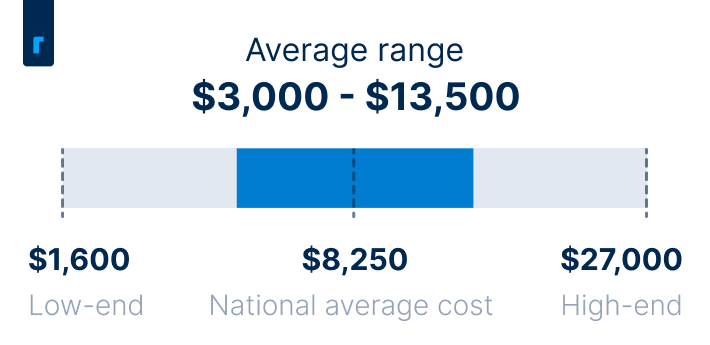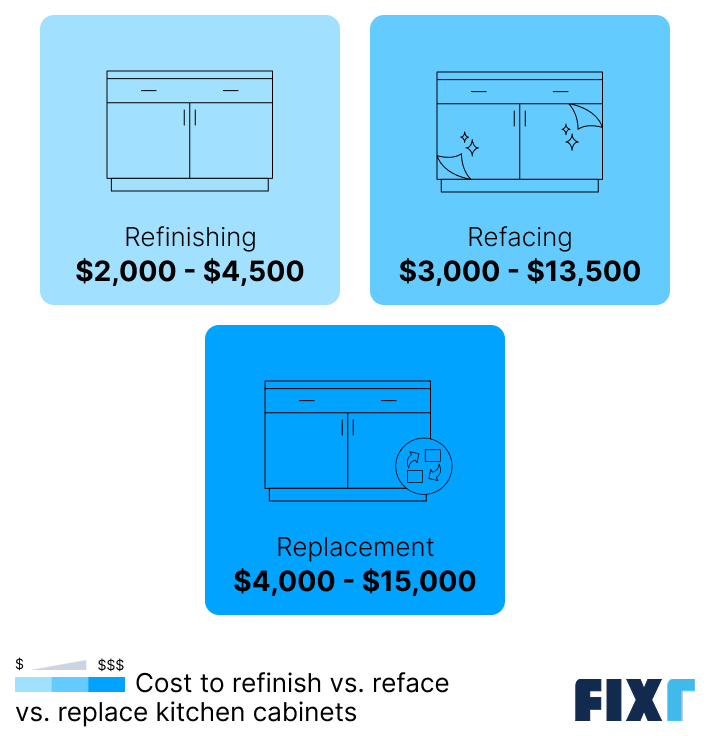Updated: October 15, 2025
Written by Dan Simms
Laura Madrigal is the Home Design Specialist at Fixr.com, dedicated to identifying and analyzing significant changes within residential design. She is the author of leading trends reports on interior design, kitchen, and bathroom, and her insights have been featured in publications like Realtor and the New York Post.
Learn moreReviewed by Laura Madrigal
When it’s time to overhaul your kitchen and give it a fresh, new look, cabinet refacing can be a valuable option that costs far less than a full replacement and takes a fraction of the time. Cabinet refacing lasts for 10 to 20 years, so it’s not as permanent as a replacement, but it can still breathe new life into your space and add value to your home with a lower investment.
Average cabinet refacing costs sit around $8,250, and most homeowners pay somewhere between $3,000 and $13,500. Prices vary widely because there are many factors that can affect your costs, including the materials you choose, the size and layout of your kitchen, and the scope of the project. You could pay as little as $1,600 to reface cabinets in a small kitchen, and prices can climb to $27,000 to reface cabinets with high-end hardwood in an oversized kitchen.
Average Cost of Cabinet Refacing


Cabinet Refacing Cost Factors
There are a few key factors you’ll need to consider to get an accurate estimate for your project. Be sure to think about all of the following to avoid surprises.
Kitchen Cabinet Refacing Cost per Linear Foot
The average overall cost of cabinet refacing is $275 per linear foot, and prices can range from $100 up to $450, depending on material choices. Most professionals charge based on the linear feet of cabinets they’ll be refacing, which means kitchen size and layout play important roles in your total.
You can also estimate your costs based on the number of cabinets you have if you can’t get accurate measurements, although these numbers can vary more due to different cabinets and cabinet door sizes. The average cabinet refacing cost per door is $435.
Average Cost to Reface Kitchen Cabinets by Kitchen Size
Another good way to estimate kitchen refacing costs is to go based on the size of your kitchen, as the room size and layout determine how many linear feet of cabinetry you need to reface.
A small kitchen that’s under 150 square feet will usually have between 16 and 25 linear feet of cabinets. A medium kitchen that’s between 150 and 250 square feet will typically have between 25 and 30 linear feet of cabinets. A large kitchen that’s over 250 square feet will have 30 linear feet of cabinets or more.
Small Kitchen (under 150 sq. ft.): $4,400 to $6,875
Medium Kitchen (150-250 sq. ft.): $6,875 to $8,250
Large Kitchen (over 250 sq. ft.): $8,250+
Cost to Reface Cabinets by Material
There are a few different materials you can choose from to reface your cabinets, and the cost ranges widely depending on which you choose.
Laminate: Laminate, which is often called thermofoil laminate, is the most affordable option at $80 to $125 per linear foot, but it’s also the least durable. It can peel over time, especially with exposure to moisture, and it has the shortest lifespan.
Wood veneer: Wood veneer costs $100 to $250 per linear foot, and it falls in the middle in terms of cost and durability. It can separate over time, and you can’t refinish it, but it provides a similar high-end look to solid wood at a fraction of the cost.
Solid wood: Solid wood is the most expensive material choice, costing $200 to $500 per linear foot, but it will stand up the best to water and humidity, it lasts the longest, looks the best, and gives you the option to refinish down the road.
Labor Cost of Cabinet Refacing
Cabinet refacing is a time- and labor-intensive process, so labor will make up a significant portion of your cost. Labor accounts for between 50% and 70% of your total, or an average of between $4,125 and $5,775 for an average-size kitchen.
Labor for cabinet refacing is expensive because it involves careful measurements to get properly sized materials, removing your cabinet doors and stripping the hardware, preparing all of the surfaces, installing the new veneers and making adjustments as needed, and reinstalling doors, cabinet pulls, and hinges..
Cabinet Refacing vs. Replacement vs. Refinishing Cost
When refreshing your kitchen cabinets, you have three main options: refacing, refinishing, and replacing. The best choice depends on the condition of your existing cabinets and your budget.


Refinishing
Refinishing is often the least expensive option, with costs typically ranging from $2,000 to $4,500 for a standard kitchen. This process involves stripping the existing finish, sanding the surface, and then applying a new stain or paint. It is a good option for cabinets that are in good structural condition but need a cosmetic update. However, refinishing is only suitable for solid wood or some plywood cabinets.
Refacing
Refacing cabinets is a mid-range option, with a typical cost between $3,000 and $13,500 for a standard kitchen. Refacing is a great choice if you want to change the style and look of your cabinets without a full demolition. This option is only possible if your current cabinets are structurally sound and have smooth, clean surfaces.
Replacement
Replacing your cabinets is the most expensive option, with costs ranging from $4,000 to $15,000 or more, depending on the cabinet type and material. This is a complete overhaul where your old cabinets are removed and new ones are installed. It is the best choice if your existing cabinets have significant structural damage or if you want to change your kitchen’s layout. Keep in mind that replacing cabinets can be disruptive and may require you to replace your countertops or backsplash as well.
Another key thing to note is that replacing cabinets is the only option that gives you the opportunity to change your kitchen layout. Refacing and refinishing are cosmetic changes only, so your layout will remain unaffected.
Additional Factors That Affect the Cost
The size of your kitchen, your material choices, and labor will account for the biggest swings in pricing, but there are some other minor factors you should think about that can have an additional impact on your total.
Hardware: Most professionals will replace your cabinet doors when refacing your cabinets, and most homeowners will upgrade the hardware at the same time. You may pay a bit more if you choose soft-close hinges for convenience or a high-end cabinet pull material, like brass.
Add-ons: While you’re refreshing the look of your cabinets, you may want to consider other upgrades, like adding crown molding, purchasing new cabinet doors with glass inserts, or installing under-cabinet lighting. These can all add a few hundred dollars to your total, but they can provide more utility and maximize the appeal of your kitchen.
Location: Where you live affects both labor and material costs. In metro areas, higher wages and demand drive up prices, while rural homeowners may face higher delivery fees or fewer contractor options. Regional availability of certain woods or veneers can also influence material costs.
Storage solutions: Storage solutions like cabinet organizers and under-cabinet hooks can add to your total but can make your prep space easier and more convenient to use.
Is Cabinet Refacing Worth It?
For most homeowners, cabinet refacing is a smart investment. It delivers a dramatic kitchen upgrade without the high cost or disruption of a full remodel.
According to our Cost vs. Value report, a minor kitchen remodel (which often includes refacing) has one of the highest returns on investment of all indoor projects, recouping an average of 96.1% of its cost. Beyond financial benefits, refacing is an eco-friendly choice since it reuses cabinet boxes rather than sourcing new materials and sending the old ones to a landfill.
However, cabinet refacing isn’t right for everyone. If your cabinets are structurally unsound or have suffered from water or moisture damage, replacing them may be the only viable option. Refacing also won’t let you change your kitchen’s layout or add interior storage features, so if you’re aiming for a new floor plan or enhanced functionality, opt for a full replacement instead.
DIY vs. Hiring a Professional
While DIY refacing can seem like a cost-saving option, especially with labor averaging $4,125 and $5,775, it requires precision, specialized tools, and a high level of skill. Small mistakes won’t ruin your cabinets, but they can hurt the look of your kitchen and reduce the project’s value, often leading to costly fixes or the need to hire a pro anyway. Hiring a professional ensures accurate measurements, a faster timeline, and a polished, long-lasting finish, making it the best choice for most homeowners.
How to Save Money on Cabinet Refacing
Cabinet refacing is already more budget-friendly than a full replacement, but there are additional ways to trim costs without sacrificing quality.
Shop around and get at least three estimates: Getting quotes from several companies allows you to compare costs and ensure you’re not overpaying for the project.
Opt for cost-effective materials: Solid wood and wood veneers are more expensive than laminates, so go with a thermofoil laminate if you’re on a tight budget. However, note that wood veneers and solid wood last longer and tend to look nicer.
Reuse existing hardware: Handles, pulls, and hinges add to your total, especially if you’re upgrading to soft-close hinges and high-end pulls and handles. If your current hardware is in good condition, consider keeping it.
Limit the upgrades: If refacing is part of a larger remodel, you can keep costs down by limiting how many other upgrades you make. Keep your existing countertops and backsplash and resist the urge to add undercabinet lighting and organizers, which will drive up costs.
Handle removal yourself: Removing old cabinet doors and hardware before the pros arrive can cut down on labor expenses. Just be sure to coordinate with your professional so you’re not waiting days or weeks with a stripped-down kitchen.
FAQs
On average, expect to pay $8,250 to reface kitchen cabinets in a standard-size kitchen.
Cabinet refacing is a method of freshening up the look of your kitchen cabinets without having to remove and replace them. It involves replacing doors, drawer fronts, and hardware, as well as installing a new face over the cabinet boxes.
With quality materials and proper installation, refaced cabinets typically last 10 to 20 years or more, comparable to brand-new cabinets. Longevity depends on both material quality and workmanship. Laminate refacing has the shortest lifespan, while solid wood is the most durable and costly. Wood veneer offers a middle ground in both price and durability.
It’s almost always going to be cheaper to reface cabinets than it is to replace them, as you’ll pay far less for the materials, and the labor costs will be lower thanks to the process being less time-consuming. Refacing cabinets may not always be possible or advisable, though. If your existing cabinets have suffered major damage or are structurally compromised, you’ll have to splurge on replacement.
In most cases, your professional will be able to complete cabinet refacing in an average-size kitchen in three to five days. Larger kitchens and more complex layouts may extend that timeline. Keep in mind that this doesn’t include measurements and material ordering, so from your first call with a pro to completion, expect to wait up to around three weeks.
The cheapest way to reface cabinets is to choose a thermofoil laminate and keep your existing hinges, pulls, and handles. Just keep in mind that more affordable refacing materials, like laminates, tend to have shorter lifespans, so long-term costs could end up being higher.
